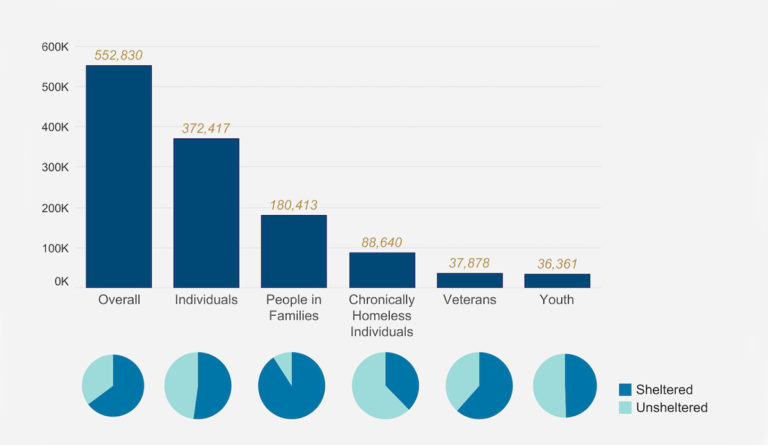Housing the Homeless
The number of people who are homeless has decreased in the US since 2007, but we have not seen increases in housing for all populations.

Read Time: 2 minutes
Published:
The US Department of Housing and Urban Development conducts a point-in-time survey of homelessness across the country every year. The department counts the number people who lack fixed, regular, and adequate nighttime residence and those who temporarily sleep in a shelter or in places not designated for human habitation. In 2018, 552,830 people were homeless on the night of the survey. This population included families with children (33%), youth (6.6%), veterans (6.8%), and adults (53.6%).

var divElement = document.getElementById(‘viz1582136130484’); var vizElement = divElement.getElementsByTagName(‘object’)[0]; if ( divElement.offsetWidth > 800 ) { vizElement.style.width=’800px’;vizElement.style.height=’527px’;} else if ( divElement.offsetWidth > 500 ) { vizElement.style.width=’800px’;vizElement.style.height=’527px’;} else { vizElement.style.width=’100%’;vizElement.style.height=’487px’;} var scriptElement = document.createElement(‘script’); scriptElement.src = ‘https://public.tableau.com/javascripts/api/viz_v1.js’; vizElement.parentNode.insertBefore(scriptElement, vizElement);
Homelessness in the US has decreased by 15% since 2007, but this reduction has not affected all populations equally. Veterans and families experienced the most notable drops in homelessness. Veteran homelessness decreased by 38%, while homelessness among people in families decreased by 23%. Non-veteran adults who were homeless experienced far less progress, with their rates dropping only 10% between 2007 and 2018.
Historically, shelters have been the predominant acute intervention for homelessness. But homeless service providers only have the capacity to offer temporary beds to 70% of people experiencing homelessness on a given night. This leaves 30% without access to adequate nighttime residence.
Databyte via PITbars, Jackie Janosko, 28 Oct. 2019.



